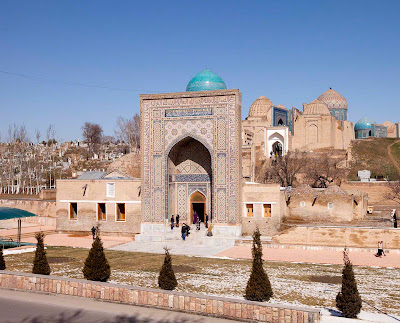Uzbekistan | Samarkand | Shah-i-Zinda
Wandered by the Shah-i-Zinda (The Living Prince) complex in Samarkand, built in large part by Amir Timur (a.k.a Tamerlane, 1336–1405) as a burial place for his female relatives, although others are also buried here. The entrance portal was added later by his grandson Ulugh Beg ((1394–1449).
Entrance Portal (click on photos for enlargements)
Entrance Portal and front of complex
Steps leading from the Entrance Portal to the mausolems
Front of one of the mausolems
Detail of front of one of the mausolems
Detail of front of one of the mausolems
Detail of front of one of the mausolems
Detail of front of one of the mausolems
Detail of front of one of the mausolems
Detail of front of one of the mausolems
Detail of front of one of the mausolems
Detail of front of one of the mausolems
Interior of one of the mausoleums. Buried here were Amir Timur’s favorite niece, her sister Turkhan Aka, and two others, one apparently a child. Not clear which tomb is which.
Interior of the mausoleum of Amir Timur’s favorite niece
Interior of the mausoleum of Amir Timur’s favorite niece
Dome of the mausoleum of Amir Timur’s favorite niece. Due to a curious optical illusion it looks convex. It is of course concave.
Interior of the mausoleum of Amir Timur’s favorite niece
Interior of the mausoleum of Amir Timur’s favorite niece
Apparently the tomb of one of Amir Timur’s wives
An unusual octagon shaped tomb
Base of the Octagon Tomb. Historians say this was the foundation of a building which pre-dated the Mongol Invasion of Samarkand in 1220. The original building was destroyed in the invasion.
More mausoleums
More mausoleums
Detail of mausoleums
Detail of mausoleums
Detail of mausoleums
Looking back toward the entrance
Another mausoleum
Detail of mausoleum
Looking toward the Kussam-Ibn-Abbas Mosque complex
Wooden door to the Kussam-Ibn-Abbas Mosque complex
Detail of wooden door to the Kussam-Ibn-Abbas Mosque complex
Detail of the door. The inscription on the column gives the name of the man who carved the door and when it was made: 1404-05
The complex is said to have included some structures which survived the destruction by the Mongols of the original buildings which stood on this site . For instance, just inside the main door is the base and entryway to a minaret said to date to the pre-Mongol era. The top of the minaret itself was destroyed by the Chingisids but the base and entryway were incorporated into the now-existing structures.
Woman praying in the mosque part of the complex
This door is said to led to an underground chamber where Sufis used to do 40-day meditation retreats
Interior of the Kussam-Ibn-Abbas Mausolem. According to legend he was a cousin of the Prophet Muhammad who accompanying a raiding party to Samarkand in 676. He was killed and buried here. His original mausoleum was apparently destroyed by the Mongols. The current mausoleum probably dates to the Timurid era.
Details of the Kussam-Ibn-Abbas Mausoleum
The tomb of the Kussam-Ibn-Abbas is behind the wooden fretwork.
Another mausoleum behind the Kussam-Ibn-Abbas complex
Detail of mausoleum behind the Kussam-Ibn-Abbas complex
Detail of mausoleum behind the Kussam-Ibn-Abbas complex
Detail of mausoleum behind the Kussam-Ibn-Abbas complex
Detail of mausoleum behind the Kussam-Ibn-Abbas complex
Detail of mausoleum behind the Kussam-Ibn-Abbas complex
I don’t usually take photos of people at places like this, but as I was leaving this guy came up to me and insisted that I take a photo of him and his family.
Love those bangs!

















































